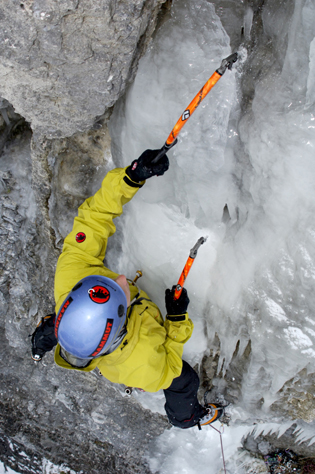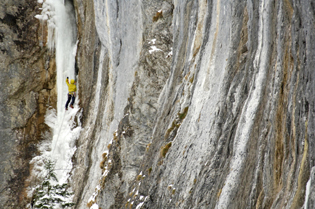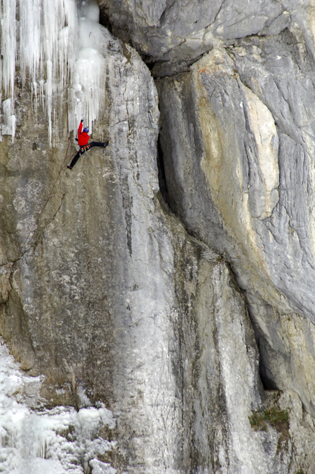


Urnerboden
The spot for dry tooling
The Gasthauswand near Urnerboden in eastern Switzerland has all the characteristics of a climbing school. Its idyllic location beside a river, its comfortable base and its quick access make it a highly prized spot.
TEXT : Nicolas Zambetti
PHOTOS : Patrice Schreyer
A good fifty or so itineraries, of varying degrees of difficulty, are on offer to the visitor. Here, it is not a matter of climbing shoes or chalk, but rather crampons and ice axes. Indeed the name “dry tooling” means trying to pick holds with the blades of tools designed for the ice. Though a few solid anchors are left on the rock on certain itineraries, it is still usual to secure your position by means of screws in the pure ice. However, other routes require the positioning of stoppers. Such a winter’s garden of mixed climbing, involving a blend of ice and rock, Urnerboden is a vast playing field where you can work on your climbing technique, your mindset as well as the various ways of securing yourself.
A still ignored potential
At the time of the explosion of ice climbing, around 20 years ago, glacier climbers logically tackled the obvious lines of pure ice. The vertical stalactites were already sufficiently tough routes as they were using the equipment available at the time. In addition, scratching crampons across the small rough edges of the rock was rather the prerogative of the north faces. A few steep and pretty ice falls were climbed for training purposes prior to larger ascents. In short, Urnerboden comprised a small site of short routes of local interest. The advent of “dry tooling” as a goal in itself would radically change this established fact and the area became a Mecca for this type of climbing.
The German guide Robert Jasper opened fire with “Rock and ice”. This evocative name designates a superb column of ice reached via the rock. This type of ascent typically reflects what is generally referred to as ‘alpinism’, but along a single length of rope. The same climber then scales a highly aesthetic line bordering on the top level and christened “Gläsernes Herz”. Though these routes surprise and inspire adherents, repeated visits are rare or even inexistent on the “Gläsernes Herz”. The only reason for this lack of visitors is the absence of fixed equipment. As such you have to know precisely how to operate the equipment to get to the end. Indeed committed mixed climbing requires you to be fully competent in mountaineering as well as having nerves of steel. It’s a grand art which leaves no room for error.
Doing what you can with your time
To the left of “Gläsernes Herz”, the Zurich guide Urs Odermatt is opening “Der Graf”, an extraordinary top level line which is similar to its neighbour. The only difference stems from the fact that it is fully equipped. An obvious consequence of this is that the route sees a great number of replications today.
Fortunately, a host of other more accessible and equipped itineraries await the amateur climber. This variety demonstrates that mountaineers, hikers and climbers of glaciers and “via ferratas” all have a place here ultimately. People who enjoy popular itineraries always owe this pleasure to a good devoted soul who cleans, marks out and secures the routes with anchors which can’t be pulled out.
A few impressions…
Our small “French speaking Swiss team” prided itself in the game of locality. Over the course of a weekend, we were able to test a few itineraries. The drought of autumn forbade us from sizing up the top level ‘must’ climbs, but the routes we performed gave us thrills that we’d only previously experienced in austere places where falling was to be avoided at all cost. The few reliable points we found during the routes got us away from the sometimes fatal aspect of the high mountain. It is nice to be able to work on the way you move your body and your technique in total safety without risking death with every step. However, it is desirable that the present itineraries remain in their current state as regards the equipment put in place. There are plenty of clean lines. Room must be left for those who still want to practise grand mountaineering.
Read the rest of the article in the Mountain Report magazine - Where to find ?

